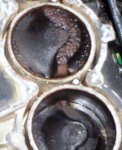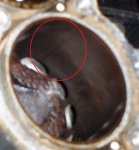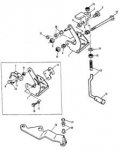I just came in from the lake today after having some unexpected problems with my '92 Force 150 in-line 5 outboard.
I read through about 50 posts before posting this one, and have to admit that my head is spinning on where to start troubleshooting.
So for those of you who may advise me to read more posts - I am - but thought that while I'm trying to figure this out I'd also post the symptoms of what happened today to see if anyone could give me a probable starting point.
Got on the lake yesterday, after filling up the boat with gas - added about 14 gallons to the tank, which has a 36 gal capacity. Mixed the TCW/3 oil in at the same time - normal proportion of 50:1.
[point 1: my wife said that there was a news story yesterday about some gas stations having bad gas - I also put about 1/2 tank in my truck at the same time, no problem driving up and back to the lake at least with the truck]
got on the lake, engine started fine, no problems, WOT is about 5200. I was running about 3000-4000 varying for about 1 hour or so, no trouble at all. Stayed on the boat overnight, idling around fishing in the evening and again this morning - no problems. Ran for about 25 minutes this afternoon at about 4000-4500 - by this time reading from the fuel gauge (have a flow meter) used about 10 gallons of gas out of the 36 gallons. Kicked it up to around 5000 and was on plane for about 10 minutes then suddenly it stumbled a couple of times, then dropped down to lower RPMs even at WOT I couldn't get it above 3000-3300 RPM, but otherwise was not running rough or anything.
Tried to pump the fuel bulb thinking maybe there was a problem with the gas flow but bulb had pressure and pumping it didn't have any effect (still stayed at max 3000-3200 instead of the normal WOT of around 5000). Gas flow as indicated by the flow meter was 10-12 gph.
Decided to turn back to the dock - still smooth but only at 3000-3200 RPM max throttle. Got within no wake zone near dock, dropped down to 900 and ran for about 5 minutes in to the dock, engine stalled about 50 feet from the dock. Restarted, stalled again, then couldn't get it started at all.
Noticed that if I put it in neutral, then maxed out the throttle, it would start and run for about 10 seconds before stalling, but would not catch when at idle throttle.
Took cover off, noticed some of the noise insulation was chewed up by the flywheel and found 4-5 pieces lying around inside the engine area [point 2: read other posts about the dust created by the insulation getting into the carbs (?)].
Pulled the 5 plugs, cleaned them. While they were out, cranked it and found it turned freely as expected.
Put plugs back on (still on the water at the dock doing this), again got it to start sluggishly a couple of times, only when in neutral and max throttle, otherwise wouldn't catch. Even then, when it started it only ran for about 5-10 seconds before stalling out.
Decided to call it a day and packed it in and trailered it home.
Now I don't know where to start:
1) Suspect bad gas? Would the above be symptomatic of bad gas? - maybe try running from a good gas supply instead of the gas in the boat?
2) Clean out the carbs or whatever on the engine due to the ground up dust from the insulation?
3) Check compression/spark/fuel pump diaphragm/reed valves as suggested on other posts? (I don't have a compression or spark tester so I'd have to get one first)
4) Is there a chance the throttle linkage got loose, slipped or something, and it isn't actually applying max throttle when the lever is all the way down? Maybe by the time I got to the dock it slipped even more or something?
I really would hate to trailer it to a mechanic (1-2 hours away) only to find it was something simple I could have dealt with at home.
Anyway, thanks in advance for those of you who were patient enough to read this to the end and comment. Back to reading more posts on the forum...
I read through about 50 posts before posting this one, and have to admit that my head is spinning on where to start troubleshooting.
So for those of you who may advise me to read more posts - I am - but thought that while I'm trying to figure this out I'd also post the symptoms of what happened today to see if anyone could give me a probable starting point.
Got on the lake yesterday, after filling up the boat with gas - added about 14 gallons to the tank, which has a 36 gal capacity. Mixed the TCW/3 oil in at the same time - normal proportion of 50:1.
[point 1: my wife said that there was a news story yesterday about some gas stations having bad gas - I also put about 1/2 tank in my truck at the same time, no problem driving up and back to the lake at least with the truck]
got on the lake, engine started fine, no problems, WOT is about 5200. I was running about 3000-4000 varying for about 1 hour or so, no trouble at all. Stayed on the boat overnight, idling around fishing in the evening and again this morning - no problems. Ran for about 25 minutes this afternoon at about 4000-4500 - by this time reading from the fuel gauge (have a flow meter) used about 10 gallons of gas out of the 36 gallons. Kicked it up to around 5000 and was on plane for about 10 minutes then suddenly it stumbled a couple of times, then dropped down to lower RPMs even at WOT I couldn't get it above 3000-3300 RPM, but otherwise was not running rough or anything.
Tried to pump the fuel bulb thinking maybe there was a problem with the gas flow but bulb had pressure and pumping it didn't have any effect (still stayed at max 3000-3200 instead of the normal WOT of around 5000). Gas flow as indicated by the flow meter was 10-12 gph.
Decided to turn back to the dock - still smooth but only at 3000-3200 RPM max throttle. Got within no wake zone near dock, dropped down to 900 and ran for about 5 minutes in to the dock, engine stalled about 50 feet from the dock. Restarted, stalled again, then couldn't get it started at all.
Noticed that if I put it in neutral, then maxed out the throttle, it would start and run for about 10 seconds before stalling, but would not catch when at idle throttle.
Took cover off, noticed some of the noise insulation was chewed up by the flywheel and found 4-5 pieces lying around inside the engine area [point 2: read other posts about the dust created by the insulation getting into the carbs (?)].
Pulled the 5 plugs, cleaned them. While they were out, cranked it and found it turned freely as expected.
Put plugs back on (still on the water at the dock doing this), again got it to start sluggishly a couple of times, only when in neutral and max throttle, otherwise wouldn't catch. Even then, when it started it only ran for about 5-10 seconds before stalling out.
Decided to call it a day and packed it in and trailered it home.
Now I don't know where to start:
1) Suspect bad gas? Would the above be symptomatic of bad gas? - maybe try running from a good gas supply instead of the gas in the boat?
2) Clean out the carbs or whatever on the engine due to the ground up dust from the insulation?
3) Check compression/spark/fuel pump diaphragm/reed valves as suggested on other posts? (I don't have a compression or spark tester so I'd have to get one first)
4) Is there a chance the throttle linkage got loose, slipped or something, and it isn't actually applying max throttle when the lever is all the way down? Maybe by the time I got to the dock it slipped even more or something?
I really would hate to trailer it to a mechanic (1-2 hours away) only to find it was something simple I could have dealt with at home.
Anyway, thanks in advance for those of you who were patient enough to read this to the end and comment. Back to reading more posts on the forum...























